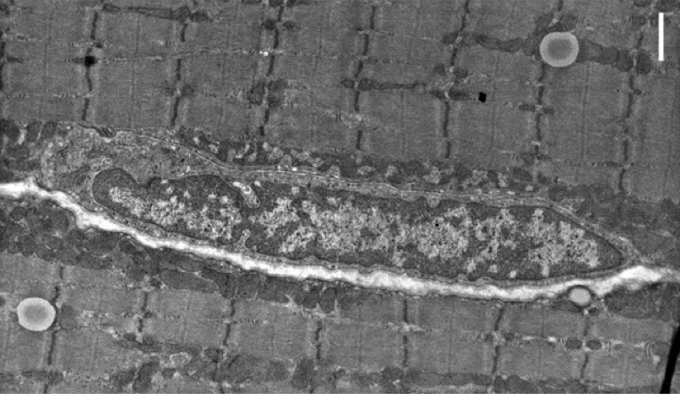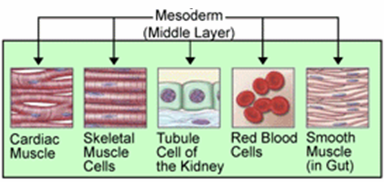30.5A: Muscle Development
- Page ID
- 8423
Myogenesis is the formation of muscle tissue during embryonic development from stem cells in the mesoderm.
- Describe the process of myogenesis, the formation of muscular tissue
Key Points
- Human embryonic stem cells are pluripotent, meaning they differentiate into all cell types, including muscle cells.
- Muscle tissue is formed in the mesoderm layer of the embryo in response to signals from fibroblast growth factor, serum response factor, and calcium.
- In the presence of fibroblast growth factor, myoblasts fuse into multi-nucleated mytotubes, which form the basis of muscle tissue.
- Unused myoblasts dedifferentiate into myosatellite cells, which remain in the muscle fiber until needed to differentiate into new muscle cells when a muscle is damaged or stressed.
- Myocytes are tubular muscle cells or fibers that develop from myoblasts.
- Myocytes are specialized as cardiac, skeletal, or smooth muscle cells.
Key Terms
- myogenesis: The formation of muscle tissue during the development of an embryo.
- mesoderm: One of the three tissue layers in the embryo of a metazoan animal. Through embryonic development, it produces many internal organs of the adult, including the muscles, spine, and circulatory system.
- myoblasts: A type of embryonic stem cell that gives rise to muscle cells.
EXAMPLES
Body builders enhance the natural developmental processes of myoblast muscle fusion and dedifferentiation into myosatellites to dramatically increase myosatellite mass, and thus muscle size and weight.
Embryogenesis is the process by which the embryo is formed and develops, until it becomes a fetus.
Characteristics of Embryoblasts

Skeletal Satellite Muscle Cell: Satellite cells are located between the basement membrane and sarcolemma (cell membrane) of individual muscle fibers. They are able to differentiate and fuse to augment existing muscle fibers and to form new ones. These cells represent the oldest known adult stem cell niche, and are involved in the normal growth of muscle, as well as regeneration following injury or disease.
The cells of the inner cell mass (embryoblast), known as human embryonic stem cells (hESCs), differentiate to form four structures: the amnion, the yolk sac, the allantois, and the embryo itself. Human embryonic stem cells are pluripotent; that is, they can differentiate into any of the cell types present in the adult human, and into any of the intermediate progenitor cell types that eventually turn into the adult cell lines. hESCs are also immortal; they can divide and grow in number indefinitely, without undergoing either differentiation or cellular aging (cellular senescence).
The first differentiation of the hESCs that form the embryo proper, is in three cell types known as the germ layers: the ectoderm, the mesoderm, and the endoderm. The ectoderm eventually forms the skin (including hair and nails), mucous membranes, and nervous system. The mesoderm forms the skeleton and muscles, heart and circulatory system, urinary and reproductive systems, and connective tissues inside the body. The endoderm forms the gastrointestinal tract (stomach and intestines), the respiratory tract, and the endocrine system (liver and endocrine glands).
The Process of Myogenesis
Myogenesis is the formation of muscular tissue, particularly during embryonic development. Muscle fibers form from the fusion of myoblasts into multi-nucleated fibers called myotubes. In early embryonic development, these myoblasts proliferate if enough fibroblast growth factor (FGF) is present. When the FGF runs out, the myoblasts cease division and secrete fibronectin onto their extracellular matrix. The second stage involves the alignment of the myoblasts into the myotubes. The third stage is the actual cell fusion itself. In this stage, calcium ions are critical for development. Myocyte enhance factors (MEFs) promote myogenesis. Serum response factor (SRF) plays a central role during myogenesis, required for the expression of striated alpha-actin genes. Expression of skeletal alpha-actin is also regulated by the androgen receptor, which means steroids can regulate myogenesis.
Characteristics of Myoblasts
A myoblast is a type of embryonic progenitor cell that differentiates to form muscle cells. Skeletal muscle fibers are made when myoblasts fuse together, so muscle fibers have multiple nuclei. The fusion of myoblasts is specific to skeletal muscle (e.g., biceps brachii), not cardiac or smooth muscle.

Mesoderm: The embryonic layer from which muscle tissues develop, including cardiac muscle, skeletal muscles cells, tubule cell of the kidney, red blood cells, and smooth muscle in gut.
Myoblasts that do not form muscle fibers dedifferentiate back into satellite (myosatellite) cells. These cells remain adjacent to a muscle fiber, situated between the sarcolemma and the endomysium (the connective tissue that divides the muscle fascicles into individual fibers). Satellite cells are able to differentiate and fuse to augment existing muscle fibers and form new ones. In undamaged muscle, the majority of satellite cells are quiescent; they neither differentiate nor undergo cell division. In response to mechanical strain, satellite cells become activated and initially proliferate as skeletal myoblasts before undergoing myogenic differentiation.
A myocyte (also known as a muscle cell or muscle fiber) is the type of cell found in muscle tissue. These long, tubular cells arise developmentally from myoblasts to form muscles. There are various specialized forms of myocytes with various properties, including cardiac, skeletal, and smooth muscle cells. Cardiac myocytes generate the electrical impulses that control heart rate and other functions.
LICENSES AND ATTRIBUTIONS
CC LICENSED CONTENT, SHARED PREVIOUSLY
- Curation and Revision. Authored by: Boundless.com. Provided by: Boundless.com. License: CC BY-SA: Attribution-ShareAlike
CC LICENSED CONTENT, SPECIFIC ATTRIBUTION
- Myoblasts. Provided by: Wikipedia. Located at: en.Wikipedia.org/wiki/Myoblasts. License: CC BY-SA: Attribution-ShareAlike
- Myogenesis. Provided by: Wikipedia. Located at: en.Wikipedia.org/wiki/Myogenesis. License: CC BY-SA: Attribution-ShareAlike
- Satellite cells. Provided by: Wikipedia. Located at: en.Wikipedia.org/wiki/Satellite_cells. License: CC BY-SA: Attribution-ShareAlike
- Embryogenesis. Provided by: Wikipedia. Located at: en.Wikipedia.org/wiki/Embryogenesis. License: CC BY-SA: Attribution-ShareAlike
- Myoblasts. Provided by: Wikipedia. Located at: en.Wikipedia.org/wiki/Myoblasts%23Myoblasts. License: CC BY-SA: Attribution-ShareAlike
- Embryomics. Provided by: Wikipedia. Located at: en.Wikipedia.org/wiki/Embryom...3Embryogenesis. License: CC BY-SA: Attribution-ShareAlike
- myoblasts. Provided by: Wikipedia. Located at: en.Wikipedia.org/wiki/myoblasts. License: CC BY-SA: Attribution-ShareAlike
- mesoderm. Provided by: Wiktionary. Located at: en.wiktionary.org/wiki/mesoderm. License: CC BY-SA: Attribution-ShareAlike
- myogenesis. Provided by: Wiktionary. Located at: en.wiktionary.org/wiki/myogenesis. License: CC BY-SA: Attribution-ShareAlike
- University of Michigan. Provided by: University of Michigan. Located at: http://umich.edu/education/med/m1/ce...2009/materials. License: CC BY-SA: Attribution-ShareAlike
- Mesoderm. Provided by: Wikimedia. Located at: commons.wikimedia.org/wiki/File:Mesoderm.png. License: Public Domain: No Known Copyright

